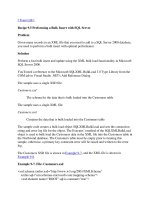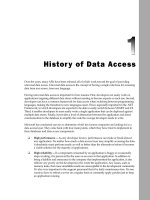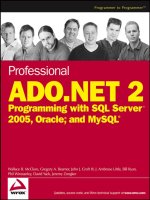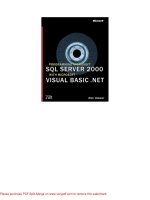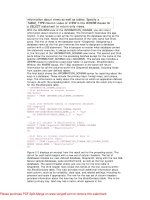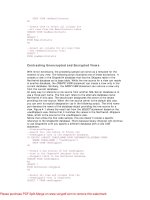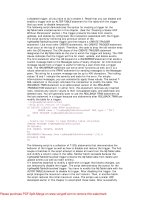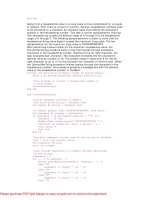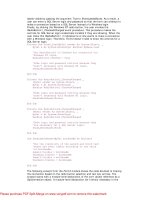Professional ADO.NET 2 Programming with SQL Server 2005, Oracle, and MySQL potx
Bạn đang xem bản rút gọn của tài liệu. Xem và tải ngay bản đầy đủ của tài liệu tại đây (1.18 MB, 50 trang )
Professional ADO.NET 2
Programming with SQL Server 2005,
Oracle®, and MySQL®
Wallace B. McClure
Gregory A. Beamer
John J. Croft IV
J. Ambrose Little
Bill Ryan
Phil Winstanley
David Yack
Jeremy Zongker
01_584375 ffirs.qxd 10/28/05 10:49 PM Page iii
Professional ADO.NET 2
Programming with SQL Server 2005,
Oracle®, and MySQL®
01_584375 ffirs.qxd 10/28/05 10:49 PM Page i
01_584375 ffirs.qxd 10/28/05 10:49 PM Page ii
Professional ADO.NET 2
Programming with SQL Server 2005,
Oracle®, and MySQL®
Wallace B. McClure
Gregory A. Beamer
John J. Croft IV
J. Ambrose Little
Bill Ryan
Phil Winstanley
David Yack
Jeremy Zongker
01_584375 ffirs.qxd 10/28/05 10:49 PM Page iii
Professional ADO.NET 2 Programming with SQL Server
2005, Oracle®, and MySQL®
Published by
Wiley Publishing, Inc.
10475 Crosspoint Boulevard
Indianapolis, IN 46256
www.wiley.com
Copyright © 2006 by Wiley Publishing, Inc., Indianapolis, Indiana
Published simultaneously in Canada
ISBN-13: 978-0-7645-8437-4
ISBN-10: 0-7645-8437-5
Manufactured in the United States of America
10 9 8 7 6 5 4 3 2 1
1B/RW/RR/QV/IN
Library of Congress Cataloging-in-Publication Data is available from the publisher.
No part of this publication may be reproduced, stored in a retrieval system, or transmitted in any form or by any means,
electronic, mechanical, photocopying, recording, scanning, or otherwise, except as permitted under Section 107 or 108 of
the 1976 United States Copyright Act, without either the prior written permission of the Publisher, or authorization
through payment of the appropriate per-copy fee to the Copyright Clearance Center, Inc., 222 Rosewood Drive, Danvers,
MA 01923, (978) 750-8400, fax (978) 646-8600. Requests to the Publisher for permission should be addressed to the Legal
Department, Wiley Publishing, Inc., 10475 Crosspoint Blvd., Indianapolis, IN 46256, (317) 572-3447, fax (317) 572-4355 or
online at />LIMIT OF LIABILITY/DISCLAIMER OF WARRANTY: THE PUBLISHER AND THE AUTHOR MAKE NO
REPRESENTATIONS OR WARRANTIES WITH RESPECT TO THE ACCURACY OR COMPLETENESS OF
THE CONTENTS OF THIS WORK AND SPECIFICALLY DISCLAIM ALL WARRANTIES, INCLUDING
WITHOUT LIMITATION WARRANTIES OF FITNESS FOR A PARTICULAR PURPOSE. NO WARRANTY
MAY BE CREATED OR EXTENDED BY SALES OR PROMOTIONAL MATERIALS. THE ADVICE AND
STRATEGIES CONTAINED HEREIN MAY NOT BE SUITABLE FOR EVERY SITUATION. THIS WORK IS
SOLD WITH THE UNDERSTANDING THAT THE PUBLISHER IS NOT ENGAGED IN RENDERING
LEGAL, ACCOUNTING, OR OTHER PROFESSIONAL SERVICES. IF PROFESSIONAL ASSISTANCE IS
REQUIRED, THE SERVICES OF A COMPETENT PROFESSIONAL PERSON SHOULD BE SOUGHT.
NEITHER THE PUBLISHER NOR THE AUTHOR SHALL BE LIABLE FOR DAMAGES ARISING HERE-
FROM. THE FACT THAT AN ORGANIZATION OR WEBSITE IS REFERRED TO IN THIS WORK AS A
CITATION AND/OR A POTENTIAL SOURCE OF FURTHER INFORMATION DOES NOT MEAN THAT
THE AUTHOR OR THE PUBLISHER ENDORSES THE INFORMATION THE ORGANIZATION OR
WEBSITE MAY PROVIDE OR RECOMMENDATIONS IT MAY MAKE. FURTHER, READERS SHOULD BE
AWARE THAT INTERNET WEBSITES LISTED IN THIS WORK MAY HAVE CHANGED OR DISAP-
PEARED BETWEEN WHEN THIS WORK WAS WRITTEN AND WHEN IT IS READ.
For general information on our other products and services please contact our Customer Care Department
within the United States at (800) 762-2974, outside the United States at (317) 572-3993 or fax (317) 572-4002.
Trademarks: Wiley, the Wiley logo, Wrox, the Wrox logo, Programmer to Programmer, and related trade
dress are trademarks or registered trademarks of John Wiley & Sons, Inc. and/or its affiliates, in the United
States and other countries, and may not be used without written permission. Linux is a registered trademark
of Linus Torvalds. MySQL is a registered trademark of MySQL AB A Company. All other trademarks are the
property of their respective owners. Wiley Publishing, Inc., is not associated with any product or vendor
mentioned in this book.
Wiley also publishes its books in a variety of electronic formats. Some content that appears in print may not
be available in electronic books.
01_584375 ffirs.qxd 10/28/05 10:49 PM Page iv
About the Authors
Wallace B. McClure
Wallace B. McClure graduated from the Georgia Institute of Technology in 1990 with a bachelor of
science degree in electrical engineering. He continued his education there, receiving a master’s degree in
the same field in 1991. Since that time, he has done consulting and development for such companies as
Coca-Cola, Bechtel National, Magnatron, and Lucent Technologies, among others. Products and
services have included work with ASP, ADO, XML, and SQL Server, as well as numerous applications in
the Microsoft .NET Framework. Wally McClure specializes in building applications that have large
numbers of users and large amounts of data. He is a Microsoft MVP and an ASPInsider, and a partner in
Scalable Development, Inc. You can read Wally’s blog at
/>Gregory A. Beamer
Gregory A. Beamer is a solutions architect specializing in Microsoft Internet technologies. Greg got
involved in programming in the early 1990s with Visual Basic 3 and has stayed on the leading edge of
Microsoft Internet technologies since the Denali beta (ASP 1.0). Greg first worked with .NET with the
PDC 2000 beta and has been on both the SQL Server 2005 and .NET 2.0 betas since spring 2003. When
Greg is not working, he spends his time with his wife, Tiffany, and their four daughters, Rebecca, Emily,
Annabelle, and Miranda.
John J. Croft IV
John J. Croft IV graduated from the Georgia Institute of Technology in 1991, receiving a bachelor’s
degree in mechanical engineering. He then spent five years consulting for large companies, including
Coca-Cola, BellSouth, and MCI. Work at these companies primarily involved C and C++ programming
and object-oriented systems analysis. His various clients have included both Fortune 100s and small
startup companies. Their problems have ranged drastically, from large databases and executive informa-
tion systems to lithotripter control and satellite telemetry. Croft has completed projects with Java, XML,
and, recently, C# and .NET applications. He is a partner in Scalable Development, Inc.
J. Ambrose Little
Ambrose is the editor-in-chief of the ASPAlliance, an ASPInsider, and a Microsoft ASP.NET MVP who
currently works as a Web architect for a large credit union in Tampa, Florida. Previously, he worked as a
consultant at Verizon, creating XML Web Services and middle-tier components, and for BOK Financial’s
Web Services department creating ASP.NET applications for their intranet. His pre NET programming
experience consists mostly of developing Web applications using ASP and VB COM/DCOM for several
years. He has a bachelor’s degree in medieval European history, which remains an interest. Apart from
developing software, he enjoys movies, reading, writing, foosball, chess, tennis, badminton, and spend-
ing time with his wonderful family.
01_584375 ffirs.qxd 10/28/05 10:49 PM Page v
vi
About the Authors
Bill Ryan
Bill currently works as a senior software developer for TiBA Solutions in Greenville, SC. He is also a
Windows Embedded MVP, has served on Macromedia’s Flash Advisory Board, and helps run two
popular .NET Focused Web sites (
www.devbuzz.com and www.knowdotnet.com) and his blog
www.msmvps.com/WilliamRyan. After earning his master’s degree in business administration, Bill
began work as a statistical analyst, but quickly realized that his true love was programming. He has
worked in multiple industries, including financial services/securities, manufacturing, health care, phar-
maceuticals, and, currently, consulting. Bill is a frequent speaker at user’s group meetings, has spoken at
multiple Microsoft Code Camps, and has hosted multiple MSDN Webcasts. Although technologically
related things consume most of his time, Bill’s other interests include cult films, economics,
Freemasonry, cuckoo clocks, and, most important, his girlfriend, Kim, and her daughter, Sarah.
Phil Winstanley
Phil Winstanley is a Web applications developer working for Portfolio Europe, located in Manchester,
England. He has been involved with ASP.NET since its inception, and has developed a deep understand-
ing of the platform. As a Microsoft MVP (Most Valuable Professional), member of the ASPInsiders,
co-owner of Microsoft Web Developers UK, and the North West England Regional Director for the .NET
Exchange, Phil is deeply embedded in the development community and works closely with the Web
Platforms team at Microsoft, regularly visiting the developers in Redmond, Washington.
David Yack
David is the president of Colorado Technology Consultants, Inc. He is a hands-on technology
consultant with solid management experience in privately held and Fortune 500 companies and has over
15 years of experience in the IT industry. David is currently responsible for leading Colorado Technology
Consultants’ focus on Microsoft .NET technologies. David is an active participant in the Microsoft
development community, ranging from the Denver .NET user group to Microsoft’s Public Communities,
such as
www.asp.net and . David is the leader of the South Colorado .NET
user group. David is recognized by Microsoft as a .NET MVP (Most Valuable Professional).
Jeremy Zongker
Jeremy Zongker is a software development manager who works primarily on data-driven ASP.NET
applications with Microsoft SQL Server databases. He is a Microsoft Certified Solutions Developer for
.NET and a 2004 MVP for ASP.NET. Jeremy is the founder and senior developer for Trilitech, LLC, a
Broken Arrow, Oklahoma, software development company.
01_584375 ffirs.qxd 10/28/05 10:49 PM Page vi
Credits
Acquisitions Editor
Bob Elliott
Development Editor
Gabrielle Nabi
Production Editor
William A. Barton
Technical Editor
Wiley - Dreamtech India Pvt Ltd
Copy Editor
Luann Rouff
Editorial Manager
Mary Beth Wakefield
Vice President and Publisher
Joseph B. Wikert
Project Coordinator
Michael Kruzil
Graphics and Production Specialists
Carrie Foster
Denny Hager
Jennifer Heleine
Alicia B. South
Quality Control Technicians
Amanda Briggs
John Greenough
Media Development Specialists
Angela Denny
Kit Malone
Travis Silvers
Proofreading and Indexing
TECHBOOKS Production Services
01_584375 ffirs.qxd 10/28/05 10:49 PM Page vii
01_584375 ffirs.qxd 10/28/05 10:49 PM Page viii
For my wife, Ronda, my two children, Kirsten and Bradley, and the rest of my family.
—Wallace B. McClure
To my loving wife and four daughters, and to God, without whom the aforementioned miracles would
not be possible.
—Greg Beamer
To my wife, Valerie, for her support, and to my boys, Jack and Conor, for their patience on the weekends
while I was writing.
—John J. Croft IV
To my mom and stepfather, for putting up with me all of these years and always being there. To my
girlfriend, Kim, and her daughter, Sarah, for always being able to make me smile.
—Bill Ryan
For my wife, Julie, and my two great kids, Drew and Jacqueline.
—David Yack
For my wife, Jeanette, for her support, patience, and understanding during the many hours I worked on
this book.
—Jeremy Zongker
To my caring father and mother, my loving brother, and to the Almighty, for giving me the power to
work every day.
—Anand Narayanaswamy,
Technical Editor
01_584375 ffirs.qxd 10/28/05 10:49 PM Page ix
01_584375 ffirs.qxd 10/28/05 10:49 PM Page x
Acknowledgments
The initial planning and thinking about this book began during a discussion of SQL Server futures in
July 2001. The discussion was with Rob Howard during a trip to Microsoft to discuss the first book I was
working on at that time. After that, I stayed involved in what was happening in ADO.NET by going to
the SQL Server Yukon Technical Preview in Bellevue, Washington, in February 2002 and by working
with the ASP.NET and SQL Server teams at Microsoft since July 2003.
Shortly after the excitement of talking with Bob Elliott at Wiley about this book wore off, it became
apparent that I would need to put together an author team that knew about the problems Microsoft was
trying to solve with ADO.NET Version 2. It is fortunate that I had recently been named a Microsoft MVP
and an ASPInsider. Based on memberships in those groups, I was able to work with and gain the respect
of Jeremy Zongker, Ambrose Little, and Phil Winstanley. From that group, I was able to meet David
Yack, William (Bill) Ryan, and Gregory Beamer. Adding these six people to John Croft and myself, we
created a really good group to work with. I want to thank them for working together very well, for
working quickly, and for examining the new features that are provided by ADO.NET 2 that are of partic-
ular interest to developers and readers of this book.
Personally, I would like to thank Bob Elliott for keeping me focused on what was going on and working
with us to develop this book. Our thanks also go out to the editorial staff at Wiley. Their help keeping us
on track as “life happened” was appreciated. The work of our technical editor, Anand Narayanaswamy,
was impressive, and his attention to detail was great. Many other people behind the scenes have worked
hard on the book. By pulling this group together, Wiley created a team that was dedicated to creating the
best possible book on ADO.NET Version 2. For that, we are truly appreciative.
— Wallace B. McClure and the author team
01_584375 ffirs.qxd 10/28/05 10:49 PM Page xi
01_584375 ffirs.qxd 10/28/05 10:49 PM Page xii
Contents
Acknowledgments xi
Contents xiii
Introduction xxv
What This Book Is About xxv
Who Should Buy This Book xxv
How to Use This Book xxvi
What This Book Covers xxvi
Providing Feedback xxvii
Chapter 1: History of Data Access 1
The Early Days 2
CODASYL 2
IMS 3
Relational Databases 3
The Birth of Universal Data Access 4
ODBC 4
OLE-DB 5
Data Access Consumers 6
DAO 6
RDO 7
ADO 8
ADO.NET 10
ADO.NET 2.0 11
Summary 12
For More Information 12
Chapter 2: Standardized Database Objects and Design 13
Creating Databases 13
Naming Conventions 15
Tables 15
Stored Procedures 17
Primary Keys 19
Foreign Keys 20
Indexes 22
02_584375 ftoc.qxd 10/28/05 10:48 PM Page xiii
xiv
Contents
Views 22
Help with Normalization 22
Enforcing Security 23
Creating Compiled Views of Data (Reports) 23
Normalizing 24
Why Normalize Data? 24
Types of Normalization 25
Designing a Normalized Database 26
Ensuring Quality Data 26
Making a Flat Database Normalized 28
A Black Cloud on the Horizon 30
Working with Someone Else’s Database 30
Don’t Make It Worse 31
Using Views for Database Abstraction 31
Using ADO.NET to Create a Normalized View of the Data 32
Building Strongly Typed Business Objects 33
Bringing Them Together 34
To Delete or Not to Delete . . . 35
Getting at the Data from Your Code 35
Summary 37
For More Information 37
Chapter 3: ADO.NET Essentials 39
Not Another ADO Release! 39
No Revolutions 40
Obsolete APIs 40
APIs in Their Twilight Months 41
The Generic Factory Model 42
Providers 43
ADO.NET to the Rescue 44
DbProviderFactories 46
Generic Factory versus Specific Providers 47
Pros 47
Cons 47
Writing a Helper Class 48
Data Sources 51
Connection Strings 53
Connection String Collection 54
Intelligent Connection Strings 54
Provider-Specific Connection Strings 55
02_584375 ftoc.qxd 10/28/05 10:48 PM Page xiv
xv
Contents
Conditionally Adding Connection String Parameters 57
Provider-Specific Connection String Parameters 57
Connections 60
Opening a Connection (and Making Sure It’s Open) 60
Closing a Connection (and Making Sure It’s Closed) 61
Managing Exceptions 62
Provider-Specific Features 66
Schema Metadata 67
Available Information 68
Restrictions 73
Reserved Words 75
Source of the Schema Information 76
Uses for Schema Metadata 77
Commands 77
DbCommand from a Factory 77
DbCommand from a DbConnection 78
Provider-Specific Commands 78
QuoteIdentifier and UnquotedIdentifier 78
Adding DbParameters to a DbCommand 79
Parameters Are Not Generic 80
ExecuteNonQuery 81
ExecuteReader 81
ExecuteScalar 83
Output Parameters, Return Codes, Scalars, and DataReaders 84
DataSet 88
Manually Populating a DataSet 89
Using DataAdapters 89
Using DataReaders 90
DataTable 90
RowState 91
DataView 91
Serialization 92
DataTableReader 93
Streaming 93
Namespace Qualified Tables 94
Indexing Engine 94
DataSet, DataTable, DataReader, or an Object? 95
Showing Data to Users without Any Manipulation 95
Editing Data That Lives in One Table 95
Editing Data Spread across More Than One Table 95
02_584375 ftoc.qxd 10/28/05 10:48 PM Page xv
xvi
Contents
Editing Continuously Updated Data for Which the Chance of Collisions Is High 96
Getting One Value from a Database 96
Summary 96
For More Information 96
Chapter 4: Standard Data Types 97
Data Types in SQL Server 98
CHAR (CHARACTER) 98
VARCHAR (CHAR VARYING or CHARACTER VARYING) 98
TEXT and VARCHAR(MAX) 99
National Character Storage 99
INT (INTEGER) 99
BIGINT 100
SMALLINT 100
TINYINT 100
DATETIME (TIMESTAMP) 100
SMALLDATETIME 100
REAL (FLOAT(24)) and FLOAT (FLOAT and DOUBLE PRECISION) 101
NUMERIC and DECIMAL (DEC and DEC(p,s)) 101
MONEY and SMALLMONEY 102
BINARY, VARBINARY, IMAGE, and VARBINARY(MAX) (BINARY VARYING) 102
Using BINARY to Store Flags 103
BIT 107
TIMESTAMP 107
SQL_VARIANT 107
UNIQUEIDENTIFIER 108
XML 108
TABLE and CURSOR 108
Data Types in ADO.NET and .NET 109
SqlTypes 109
Other Alternatives 113
Mapping SQL Server Data Types to .NET 114
Summary 116
For More Information 116
Chapter 5: ADO.NET Integration with XML 117
What This Chapter Covers 118
Where XML Is Today 119
Data Exchange 119
XML Web Services 119
02_584375 ftoc.qxd 10/28/05 10:48 PM Page xvi
xvii
Contents
Configuration Files 120
Text Markup 120
Design Goals for System.Xml 2.0 120
XmlReader and XmlWriter 121
Factory Methods 121
Easier Object Serialization 122
Conversion between XML Types and Framework Types 123
Other XmlReader Enhancements 124
Designer Enhancements 124
XML Designer 124
XSL Debugging 125
XSD Enhancements 126
Security 127
XPathDocument 128
Editing 128
Validation 131
Change Notification 133
XSLT Improvements 134
Performance 134
Where XML Is Heading 135
XPath 2.0 135
XSLT 2.0 and XQuery 135
XML Views 136
ObjectSpaces 136
Summary 137
For More Information 137
Chapter 6: Transactions 139
Basic Concepts 139
A.C.I.D 140
Transaction Types 141
Isolation Levels 142
Creating a Local Transaction 143
Distributed Transactions 145
Distributed Transactions in ADO.NET 2.0 146
Monitoring Transactions and Their Performance 149
How Does This Affect Local Data? 150
Nested Transactions 153
Transactions in Web Services 155
Flow-Through Transactions 156
02_584375 ftoc.qxd 10/28/05 10:48 PM Page xvii
xviii
Contents
Getting System.Transactions to Work Correctly 156
Summary 157
For More Information 157
Chapter 7: Data Binding 159
Windows Forms versus Web Applications 159
The Concept of Data Binding 160
Options for Getting the Data 160
One-Way Binding versus Two-Way Binding 163
Data Binding in ASP.NET 163
Benefits of the Data Source Concept 164
Data Source Controls Provided with ASP.NET 2.0 164
Passing Parameters to Data Source Controls 165
Validation of Parameter Data 166
Data Source Caching 167
The ASP.NET UI Controls 169
SQLDataSource Control 170
Beware of Provider-Specific Syntax 175
ObjectDataSource Control 176
Table Adapter and Typed DataSets 185
Generating DataSource Controls 189
Windows Forms Applications 191
Where Did My Data Components Go? 192
Dragging and Dropping a Table 192
Data Sources 192
The Windows Form UI Controls 197
Summary 199
For More Information 199
Chapter 8: Building a Custom ADO.NET Data Provider 201
A Brief Overview 202
AdsConnection 203
AdsConnectionStringBuilder 209
AdsCommand 211
AdsDataReader 219
User Properties versus Active Directory Properties 221
Other AdsDataReader Members 226
AdsDataAdapter 228
AdsFactory 231
02_584375 ftoc.qxd 10/28/05 10:48 PM Page xviii
xix
Contents
Getting Ready for Use 233
Summary 233
For More Information 234
Chapter 9: T-SQL Language and Enhancements 235
An In-Depth Look at T-SQL 238
Structured Exception Handling 240
OUTPUT 249
Top X 250
Common Table Expressions 252
PIVOT 254
UNPIVOT 256
Ranking 256
Summary 264
For More Information 264
Chapter 10: ADO.NET Programming with SQL Server from a Client Application 265
SQL Server and ADO.NET 265
Asynchronous Commands in ADO.NET 266
BeginExecuteNonQuery 267
BeginExecuteReader 269
BeginExecuteXMLReader 271
Asynchronous Operations in ASP.NET 272
IAsyncResult 275
Final Words of Warning with Asynchronous Operations 276
Multiple Active Result Sets 276
What Is MARS Useful For? 277
Technical Issues with MARS 277
Enumerating SQL Servers 278
Connection Pooling 279
Password Management 280
Building a SQL Connection with the SqlConnectionStringBuilder Class 281
SQL Server Types (SqlTypes) 283
Structures 284
Using SqlTypes 287
Using SqlDbType 290
Bulk Copy with SQL Server 291
Provider Statistics 292
SqlCacheDependency 293
02_584375 ftoc.qxd 10/28/05 10:48 PM Page xix
xx
Contents
SqlCacheDependencyAdmin 297
SqlDependency 297
Summary 300
For More Information 300
Chapter 11: SQL Server 2005 Server-Side Programming 301
Extended Stored Procedures 301
CLR Objects 302
Set-Based Programming 302
Procedural Programming 303
Using CLR Objects 303
Creating CLR Objects 304
SQL Server Projects 306
Assemblies and CLR Object Tables/Functions 310
Triggers 311
SqlTriggerContext 311
Updating Columns 313
EventData for DDL Triggers 313
Sample Code 314
Stored Procedures 318
Functions 319
User-Defined Types 324
User-Defined Sample Code 324
Manually Creating Tabular Results 326
SqlContext 327
The Context Connection 327
SQL CLR Architecture 328
Placing Business Logic 328
When to Use T-SQL and CLR Objects 329
SQL Server Management Objects 329
General Design 330
Referencing Objects through URN 331
Creating Objects 331
Creating a Database 332
Creating a Table, Its Columns, and an Index 334
Creating a User 336
Creating a Foreign Key 337
Creating a Backup 338
Scripting with SMO 341
XML Web Services Processing in the Database 343
02_584375 ftoc.qxd 10/28/05 10:48 PM Page xx
xxi
Contents
Creating an Endpoint 344
Summary 346
For More Information 346
Chapter 12: Notification Services 347
Major Components 348
Subscription Management Application 348
Event Provider 349
Generator 349
Distributor 350
Instances and Applications 350
Configuring the Instance 350
The Application Definition File 352
Adding the SQL NS Instance 356
Building the Subscription Management Application 357
Retrieving a List of Subscribers 357
Adding/Removing a Subscriber 358
Device List 360
Device Edit 361
Subscription List 363
Subscription Edit 364
Firing an Event 367
Summary 368
For More Information 368
Chapter 13: Service Broker 369
An Introduction to Service Broker 369
Working with Service Broker: A Simple Example 371
Processing Messages 381
Technical Bits 394
Queues 394
Service Broker Catalog Views 396
Making It Easier 399
Summary 400
For More Information 401
Chapter 14: Full-Text Searching 403
What Is Full-Text Searching? 403
Terminology 404
02_584375 ftoc.qxd 10/28/05 10:48 PM Page xxi
xxii
Contents
How Does Full-Text Indexing Work? 405
Microsoft Full-Text Engine for SQL Server Service 405
What Does a Full-Text Index Look Like? 405
How Is a Full-Text Index Populated? 406
Predicates, Programming, and the Results 412
Queries 412
Multi-Column Queries 418
Language Settings 418
Ranking 419
Searching XML and BLOBs 422
XML 422
BLOBs 422
Extending Full-Text Search with Filters 425
Summary 426
For More Information 426
Chapter 15: Reporting 427
An Introduction to Reporting 428
Scenario 428
Implementation 428
Web Application, or “Look Ma, No Code ” (Part One) 430
Reporting Services 432
Our Simple Report in Reporting Services, or “Look Ma, no Code ” (Part 2) 432
A Brief Primer on Report Definition Language 436
Using the Reporting Service Server 438
Building Report Models, or How to Slough Some of the Work off on the Biz Guys! 460
Summary 464
For More Information 465
Chapter 16: ADO.NET 2 and Open-Source Databases 465
Open Source and Licensing 465
Databases 466
MySQL 466
MaxDB (formerly SAPdb) 477
Firebird 485
Ingres 492
PostgreSQL 497
BerkeleyDB 502
SQLite 508
Summary 512
For More Information 513
02_584375 ftoc.qxd 10/28/05 10:48 PM Page xxii
xxiii
Contents
Chapter 17: Oracle and ADO.NET 515
Choosing an Oracle Data Provider 515
Common Provider Classes 516
Microsoft Oracle Provider 517
Oracle Data Provider for .NET (ODP.NET) 518
Oracle Developer Tools for Visual Studio .NET 519
Common Oracle Errors 533
Using Tracing to Find Problems 534
Understanding Packages 535
Regular Expression Support 536
Database Change Notification 538
Using the BFile Type 543
Oracle Services for Microsoft Transaction Server 543
Oracle Database Extensions for .NET 544
Installation of the Database Extensions 544
Building a .NET Stored Procedure 544
Summary 548
For More Information 548
Appendix A: Constants/Enums in ADO.NET 549
Index 585
02_584375 ftoc.qxd 10/28/05 10:48 PM Page xxiii
